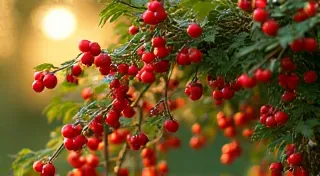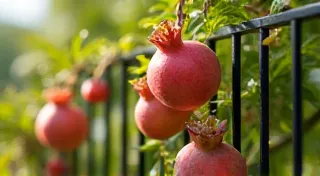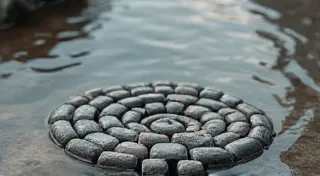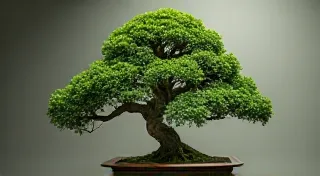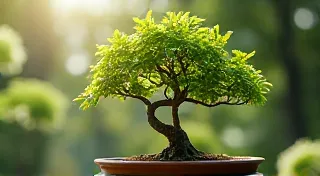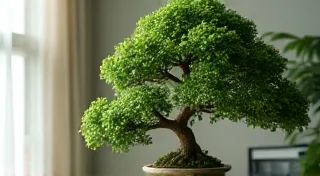Korean Hornbeam Bonsai: Understanding its Unique Characteristics
The Korean Hornbeam (Carpinus koreana) is gaining popularity among bonsai enthusiasts for its beautiful foliage, relatively fast growth, and adaptability. Unlike some other hornbeam species, the Korean Hornbeam displays a subtly elegant beauty, making it a rewarding choice for bonsai cultivation. This guide will delve into the unique characteristics of the Korean Hornbeam and provide essential care and styling advice to help you create a thriving bonsai.
Understanding the Korean Hornbeam
Native to Korea and parts of Russia, the Korean Hornbeam is a deciduous tree known for its graceful branching structure and consistently beautiful foliage. It’s often mistaken for the European Hornbeam (Carpinus betulus>), but Korean Hornbeam exhibits a slightly more refined appearance with more delicate leaves. Its bark is smooth and gray, adding to its overall aesthetic appeal. One of the most charming aspects of this tree is its subtle color changes throughout the year; leaves transition from vibrant green in spring and summer to a beautiful golden-yellow in the autumn. The versatility of deciduous bonsai is a significant draw for many, and if you’re relatively new to bonsai, a species like the Chinese Elm Bonsai can be a great place to start.

Care Requirements for a Korean Hornbeam Bonsai
Successful Korean Hornbeam bonsai cultivation hinges on providing the right environmental conditions and implementing consistent care practices.
Light & Location
Korean Hornbeams thrive in full sun to partial shade. While they can tolerate some shade, they require at least 6 hours of direct sunlight daily to encourage healthy growth and vibrant foliage color. When grown outdoors, protect your bonsai from harsh afternoon sun, especially during the hottest months of summer. Indoor placement should be near a bright window with supplemental grow lights if natural light is insufficient. Finding the right balance of light is crucial for all bonsai, similar to the challenges faced when cultivating an Azalea Bonsai and achieving those vibrant blooms.
Watering
Watering frequency will vary depending on the climate, soil mix, and pot size. Generally, Korean Hornbeams prefer consistently moist soil but dislike being waterlogged. Check the soil daily; water when the top inch feels dry to the touch. Ensure the pot has excellent drainage to prevent root rot.
Soil & Repotting
A well-draining bonsai soil mix is crucial. A blend of Akadama, pumice, and lava rock is a commonly recommended mix. Repotting should be done every 2-3 years in early spring, using a slightly larger pot each time as needed. Gently prune the roots during repotting to encourage ramification. The soil and repotting process is a universal aspect of bonsai care, requiring similar attention whether you're working with a Korean Hornbeam or a more readily propagated species like a Fig Bonsai.
Fertilizing
Korean Hornbeams are relatively heavy feeders. During the growing season (spring and summer), fertilize regularly with a balanced bonsai fertilizer. Reduce or eliminate fertilization during the dormant season (fall and winter).
Pruning & Shaping
Pruning is essential for maintaining the desired shape and size of your Korean Hornbeam bonsai. Pinch back new growth regularly to encourage ramification. Structural pruning should be performed in late winter or early spring before new growth emerges. Wiring can be used to manipulate branches into desired positions. The art of pruning and shaping requires a keen eye and a steady hand, and the techniques are broadly applicable across many bonsai species, much like those used to enhance the beauty of a Larch Bonsai, with its seasonal beauty.

Styling Considerations
Korean Hornbeams are versatile and can be styled in a variety of classic bonsai forms. Popular styles include:
Remember to consider the tree's natural growth habit when selecting a style. Korean Hornbeams have a tendency to create thick, strong trunks, so a style that showcases this feature will be particularly rewarding. Experimentation is key, and understanding the underlying principles will allow you to adapt styles to suit individual trees. The choice of style often reflects the desired aesthetic – a sweeping, natural look or a more structured, formal appearance.
Potential Challenges and Solutions
Like any bonsai species, Korean Hornbeams can be susceptible to certain challenges. Common issues include:
Prevention is always better than cure, and maintaining a healthy environment through proper watering, fertilization, and sunlight exposure will significantly reduce the likelihood of encountering these problems. Regular inspection of your bonsai is also essential for early detection and prompt treatment. Understanding these common issues helps you proactively manage your bonsai’s health and longevity.

Propagation and Expansion
While Korean Hornbeams are not typically propagated from seed, vegetative propagation through cuttings can be attempted. However, this method requires patience and specialized techniques. For those interested in expanding their bonsai collection or sharing their passion, exploring various propagation methods is a rewarding endeavor, though often requiring dedicated resources and expertise. The ability to propagate and share your favorite species is a defining characteristic of skilled bonsai enthusiasts.
Conclusion
The Korean Hornbeam bonsai offers a delightful combination of beauty, resilience, and adaptability. With proper care and attention to detail, you can cultivate a thriving and stunning bonsai that will provide years of enjoyment. Its subtle elegance and relatively easy-going nature make it an excellent choice for both beginner and experienced bonsai enthusiasts alike. The journey of bonsai cultivation is a continuous learning process, filled with challenges and rewards. Embrace the learning curve and enjoy the meditative practice of nurturing these miniature masterpieces.
